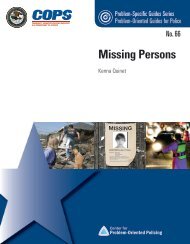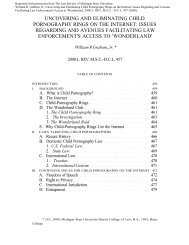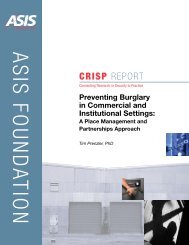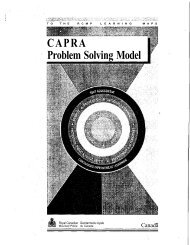Child Pornography: - Center for Problem-Oriented Policing
Child Pornography: - Center for Problem-Oriented Policing
Child Pornography: - Center for Problem-Oriented Policing
You also want an ePaper? Increase the reach of your titles
YUMPU automatically turns print PDFs into web optimized ePapers that Google loves.
may only be prosecuted <strong>for</strong> a single count of possession with intent to promote, 325 but a defendant<br />
in possession of several copies of the same photograph could be convicted <strong>for</strong> simple<br />
possession of each article. 326<br />
Massachusetts prohibits not only possession but also the knowing purchase of child<br />
pornography, 327 while New Jersey also prohibits knowingly viewing child pornography on<br />
the Internet. 328 In addition Nebraska has a unique provision that includes children as portrayed<br />
observers in its possession statute, making it "unlawful <strong>for</strong> a person to knowingly<br />
possess with intent to rent, sell, deliver, distribute, trade, or provide to any person any visual<br />
depiction of sexually explicit conduct [that] has a child as one of its participants or portrayed<br />
observers."<br />
Distribution of Material Harmful to Minors<br />
Thirty states prohibit the distribution or display of materials that are either obscene or harmful<br />
to minors. 329 The material distributed to the minor need not be child pornography. South Carolina<br />
defines "harmful-to-minors" as "that quality of any materials or per<strong>for</strong>mance that depicts<br />
sexually explicit nudity or sexual activity and that, taken as a whole, has the.. characteristics<br />
[noted below.]<br />
• the average adult person applying contemporary community standards would find<br />
that the material or per<strong>for</strong>mance has a predominant tendency to appeal to a prurient<br />
interest of minors in sex<br />
• the average adult person applying contemporary community standards would find<br />
that the depiction of sexually explicit nudity or sexual activity in the material or<br />
per<strong>for</strong>mance is patently offensive to prevailing standards in the adult community<br />
concerning what is suitable <strong>for</strong> minors<br />
• to a reasonable person the material or per<strong>for</strong>mances taken as a whole lacks serious<br />
literary, artistic, political, or scientific value <strong>for</strong> minors 330<br />
Distributing or displaying obscene or harmful materials to a minor can include displaying<br />
pornographic magazines without a "blinder rack" or wrapper over the lower two-thirds of the<br />
magazine cover 331 or admitting minors to public displays of sexual conduct such as obscene<br />
films in an outdoor theater. 332 Wisconsin also prohibits intentionally causing a child to view or<br />
listen to sexually explicit conduct if the viewing or listening is <strong>for</strong> the person's own sexual<br />
arousal or gratification or humiliation or degradation of the child. 333 Kentucky further prohibits<br />
using minors to distribute child pornography. 334<br />
Statutes prohibiting distribution of material harmful to minors, however, have received<br />
increased scrutiny when states have amended their statutes to include images sent over the<br />
Internet. A US District Court judge in Virginia recently blocked a state law designed to protect<br />
children from viewing harmful material on the Internet ruling that the statute violates the<br />
First Amendment rights of Internet users and providers. 335 An Oregon Court of Appeals made<br />
a similar ruling based on the state constitution's free-speech protections. It suggested the legislature<br />
could remedy the statutory defect because, under a separate state Supreme Court<br />
ruling on child pornography, it was permissible to regulate such "speech" as long as the law<br />
focused on its harmful effects rather than its offensive content. 336 Cali<strong>for</strong>nia has narrowly<br />
tailored its statute, which makes it unlawful to send sexual messages electronically to seduce<br />
a minor, to overcome such challenges. The statute requires proof that the transmission was<br />
intended to seduce someone the sender knew, or should have known, was a minor. 337<br />
30 - CHILD PORNOGRAPHY: THE CRIMINAL-JUSTICE-SYSTEM RESPONSE
















